Business Plan Report: Launching Organic Food Delivery for Woolworths
VerifiedAdded on 2020/02/24
|19
|4682
|65
Report
AI Summary
This report presents a business plan for Woolworths to introduce an organic food delivery service. It begins with an executive summary outlining the company's strategy to offer superior quality, fresh, and natural foods via an app, targeting organic consumers and aiming to gain a competitive advantage in the Australian market. The report provides a company background, detailing Woolworths' existing operations, mission, and objectives. It includes a market analysis using Porter's Five Forces, examining competition from key players like ALDI and Wesfarmers. The report details the target market, marketing strategies, and a financial plan with start-up costs, sales forecasts, projected profit and loss, balance sheet, and cash flow statements. It also identifies critical risks and concludes that the company can benefit from investing in organic food delivery services. Tables and figures are included to support the analysis.
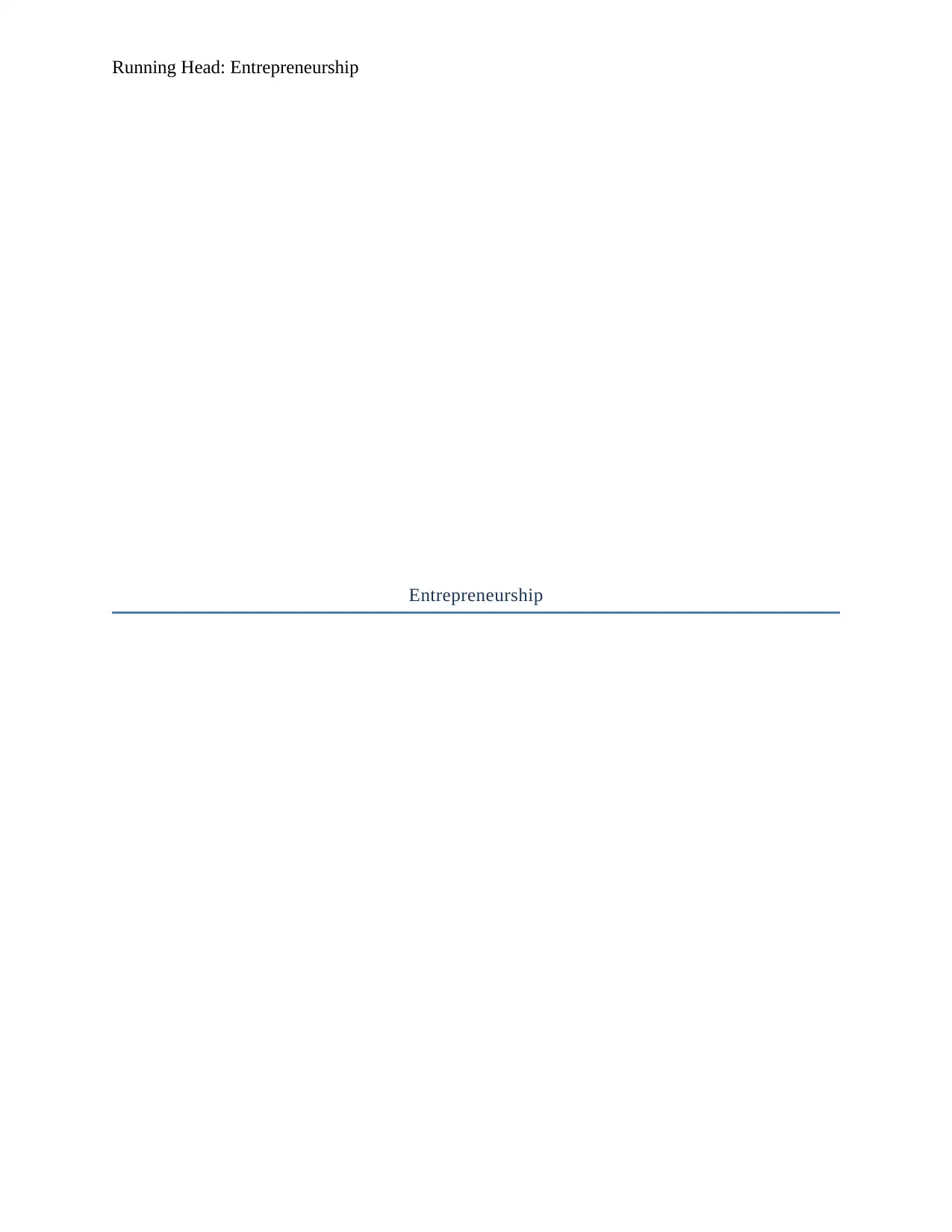
Running Head: Entrepreneurship
Entrepreneurship
Entrepreneurship
Paraphrase This Document
Need a fresh take? Get an instant paraphrase of this document with our AI Paraphraser
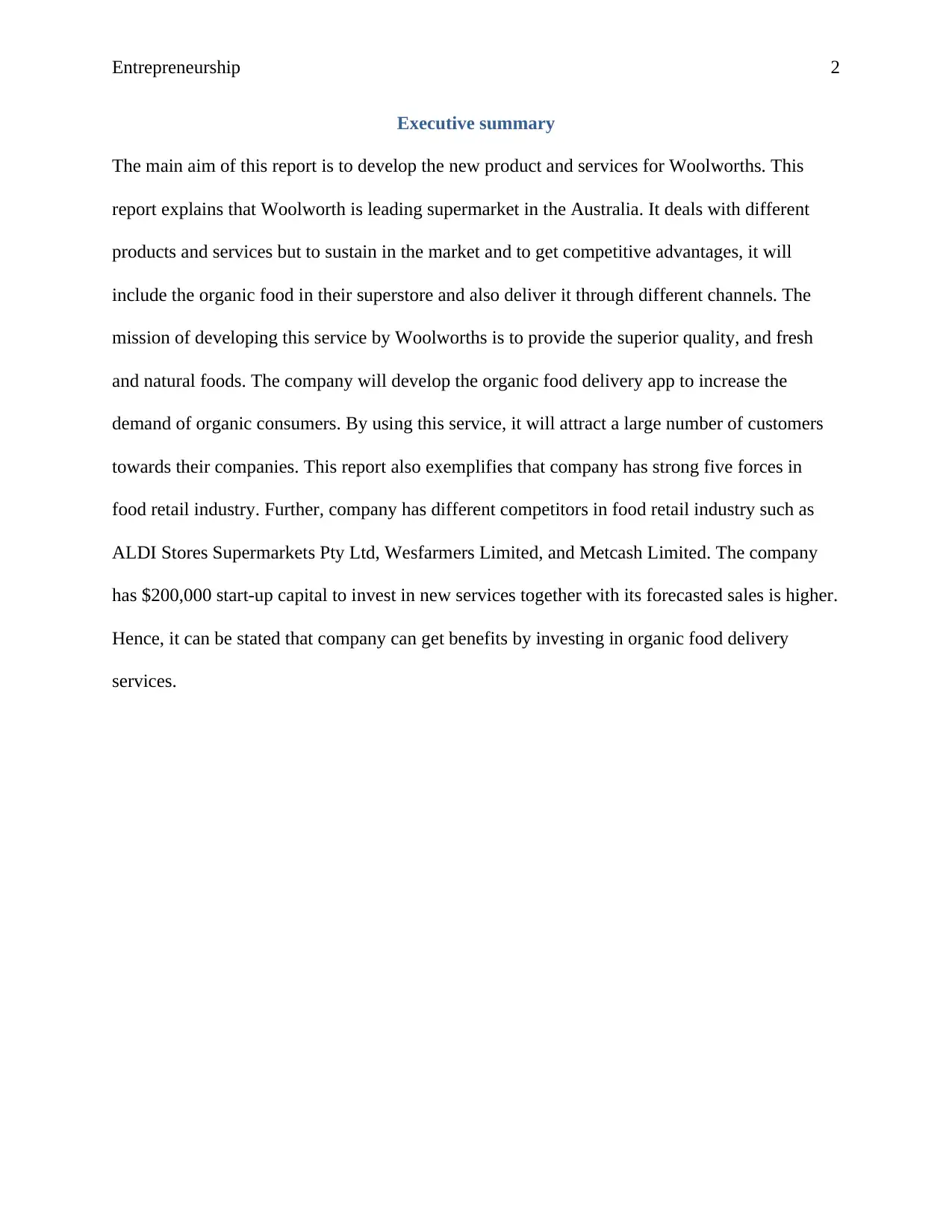
Entrepreneurship 2
Executive summary
The main aim of this report is to develop the new product and services for Woolworths. This
report explains that Woolworth is leading supermarket in the Australia. It deals with different
products and services but to sustain in the market and to get competitive advantages, it will
include the organic food in their superstore and also deliver it through different channels. The
mission of developing this service by Woolworths is to provide the superior quality, and fresh
and natural foods. The company will develop the organic food delivery app to increase the
demand of organic consumers. By using this service, it will attract a large number of customers
towards their companies. This report also exemplifies that company has strong five forces in
food retail industry. Further, company has different competitors in food retail industry such as
ALDI Stores Supermarkets Pty Ltd, Wesfarmers Limited, and Metcash Limited. The company
has $200,000 start-up capital to invest in new services together with its forecasted sales is higher.
Hence, it can be stated that company can get benefits by investing in organic food delivery
services.
Executive summary
The main aim of this report is to develop the new product and services for Woolworths. This
report explains that Woolworth is leading supermarket in the Australia. It deals with different
products and services but to sustain in the market and to get competitive advantages, it will
include the organic food in their superstore and also deliver it through different channels. The
mission of developing this service by Woolworths is to provide the superior quality, and fresh
and natural foods. The company will develop the organic food delivery app to increase the
demand of organic consumers. By using this service, it will attract a large number of customers
towards their companies. This report also exemplifies that company has strong five forces in
food retail industry. Further, company has different competitors in food retail industry such as
ALDI Stores Supermarkets Pty Ltd, Wesfarmers Limited, and Metcash Limited. The company
has $200,000 start-up capital to invest in new services together with its forecasted sales is higher.
Hence, it can be stated that company can get benefits by investing in organic food delivery
services.
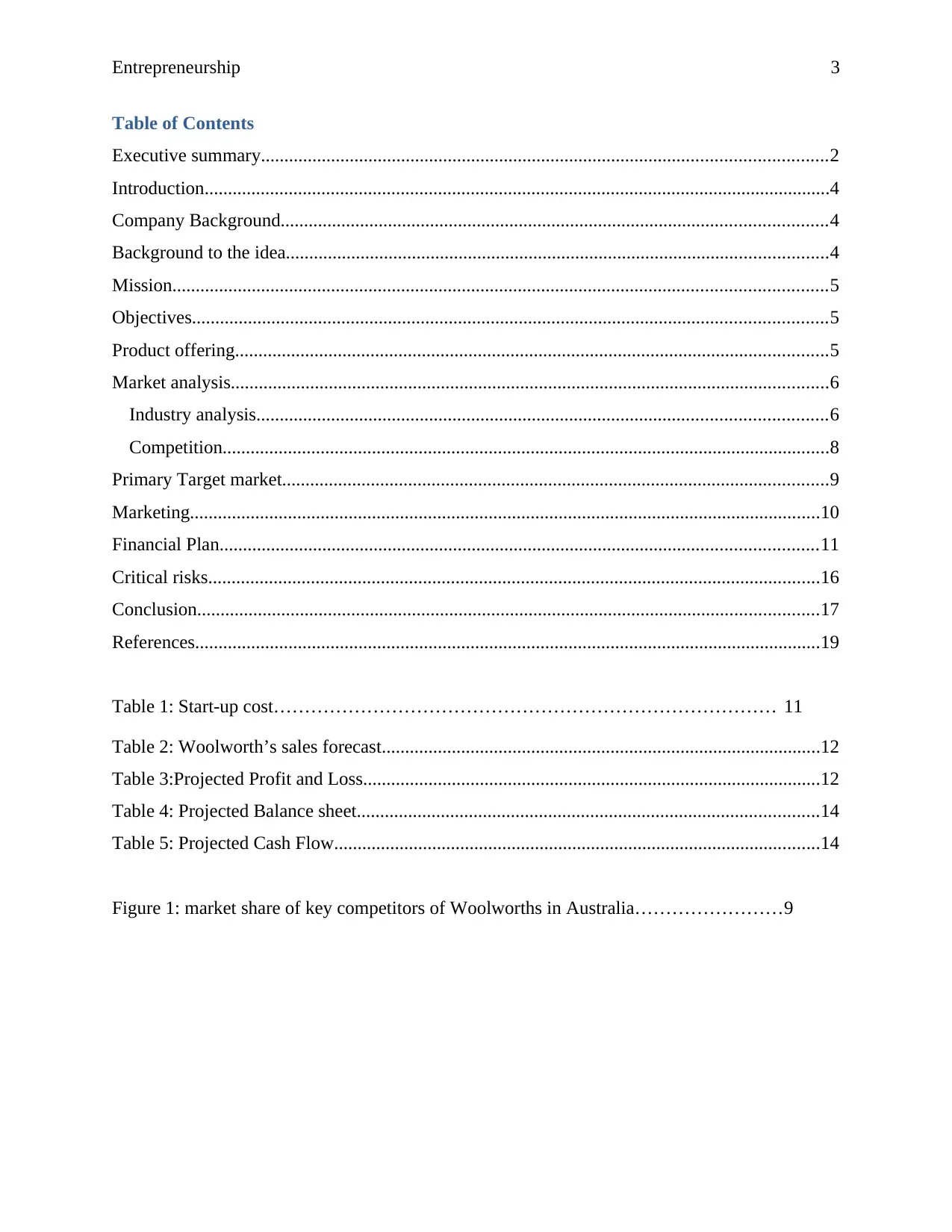
Entrepreneurship 3
Table of Contents
Executive summary.........................................................................................................................2
Introduction......................................................................................................................................4
Company Background.....................................................................................................................4
Background to the idea....................................................................................................................4
Mission............................................................................................................................................5
Objectives........................................................................................................................................5
Product offering...............................................................................................................................5
Market analysis................................................................................................................................6
Industry analysis..........................................................................................................................6
Competition..................................................................................................................................8
Primary Target market.....................................................................................................................9
Marketing.......................................................................................................................................10
Financial Plan................................................................................................................................11
Critical risks...................................................................................................................................16
Conclusion.....................................................................................................................................17
References......................................................................................................................................19
Table 1: Start-up cost……………………………………………………………………… 11
Table 2: Woolworth’s sales forecast..............................................................................................12
Table 3:Projected Profit and Loss..................................................................................................12
Table 4: Projected Balance sheet...................................................................................................14
Table 5: Projected Cash Flow........................................................................................................14
Figure 1: market share of key competitors of Woolworths in Australia……………………9
Table of Contents
Executive summary.........................................................................................................................2
Introduction......................................................................................................................................4
Company Background.....................................................................................................................4
Background to the idea....................................................................................................................4
Mission............................................................................................................................................5
Objectives........................................................................................................................................5
Product offering...............................................................................................................................5
Market analysis................................................................................................................................6
Industry analysis..........................................................................................................................6
Competition..................................................................................................................................8
Primary Target market.....................................................................................................................9
Marketing.......................................................................................................................................10
Financial Plan................................................................................................................................11
Critical risks...................................................................................................................................16
Conclusion.....................................................................................................................................17
References......................................................................................................................................19
Table 1: Start-up cost……………………………………………………………………… 11
Table 2: Woolworth’s sales forecast..............................................................................................12
Table 3:Projected Profit and Loss..................................................................................................12
Table 4: Projected Balance sheet...................................................................................................14
Table 5: Projected Cash Flow........................................................................................................14
Figure 1: market share of key competitors of Woolworths in Australia……………………9
⊘ This is a preview!⊘
Do you want full access?
Subscribe today to unlock all pages.

Trusted by 1+ million students worldwide
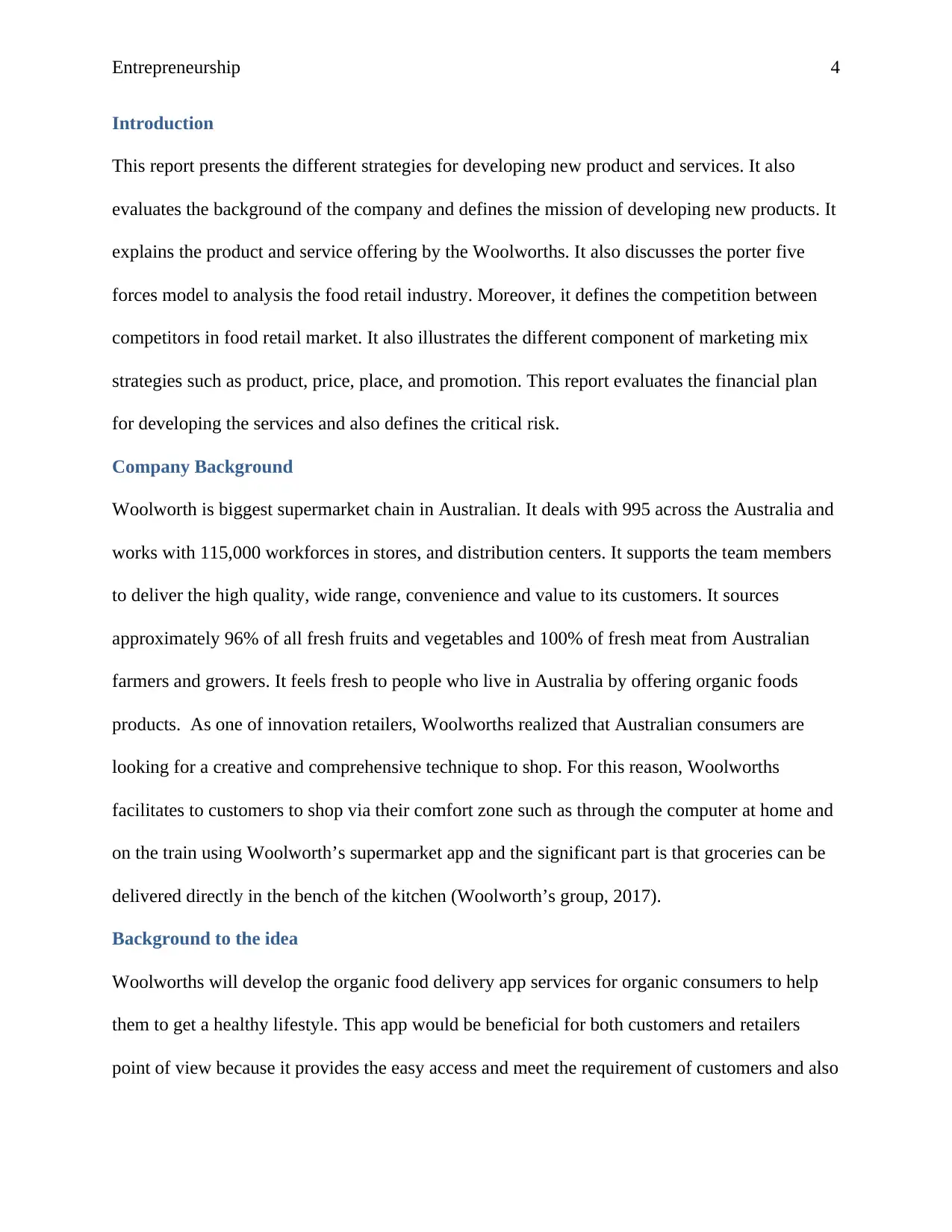
Entrepreneurship 4
Introduction
This report presents the different strategies for developing new product and services. It also
evaluates the background of the company and defines the mission of developing new products. It
explains the product and service offering by the Woolworths. It also discusses the porter five
forces model to analysis the food retail industry. Moreover, it defines the competition between
competitors in food retail market. It also illustrates the different component of marketing mix
strategies such as product, price, place, and promotion. This report evaluates the financial plan
for developing the services and also defines the critical risk.
Company Background
Woolworth is biggest supermarket chain in Australian. It deals with 995 across the Australia and
works with 115,000 workforces in stores, and distribution centers. It supports the team members
to deliver the high quality, wide range, convenience and value to its customers. It sources
approximately 96% of all fresh fruits and vegetables and 100% of fresh meat from Australian
farmers and growers. It feels fresh to people who live in Australia by offering organic foods
products. As one of innovation retailers, Woolworths realized that Australian consumers are
looking for a creative and comprehensive technique to shop. For this reason, Woolworths
facilitates to customers to shop via their comfort zone such as through the computer at home and
on the train using Woolworth’s supermarket app and the significant part is that groceries can be
delivered directly in the bench of the kitchen (Woolworth’s group, 2017).
Background to the idea
Woolworths will develop the organic food delivery app services for organic consumers to help
them to get a healthy lifestyle. This app would be beneficial for both customers and retailers
point of view because it provides the easy access and meet the requirement of customers and also
Introduction
This report presents the different strategies for developing new product and services. It also
evaluates the background of the company and defines the mission of developing new products. It
explains the product and service offering by the Woolworths. It also discusses the porter five
forces model to analysis the food retail industry. Moreover, it defines the competition between
competitors in food retail market. It also illustrates the different component of marketing mix
strategies such as product, price, place, and promotion. This report evaluates the financial plan
for developing the services and also defines the critical risk.
Company Background
Woolworth is biggest supermarket chain in Australian. It deals with 995 across the Australia and
works with 115,000 workforces in stores, and distribution centers. It supports the team members
to deliver the high quality, wide range, convenience and value to its customers. It sources
approximately 96% of all fresh fruits and vegetables and 100% of fresh meat from Australian
farmers and growers. It feels fresh to people who live in Australia by offering organic foods
products. As one of innovation retailers, Woolworths realized that Australian consumers are
looking for a creative and comprehensive technique to shop. For this reason, Woolworths
facilitates to customers to shop via their comfort zone such as through the computer at home and
on the train using Woolworth’s supermarket app and the significant part is that groceries can be
delivered directly in the bench of the kitchen (Woolworth’s group, 2017).
Background to the idea
Woolworths will develop the organic food delivery app services for organic consumers to help
them to get a healthy lifestyle. This app would be beneficial for both customers and retailers
point of view because it provides the easy access and meet the requirement of customers and also
Paraphrase This Document
Need a fresh take? Get an instant paraphrase of this document with our AI Paraphraser
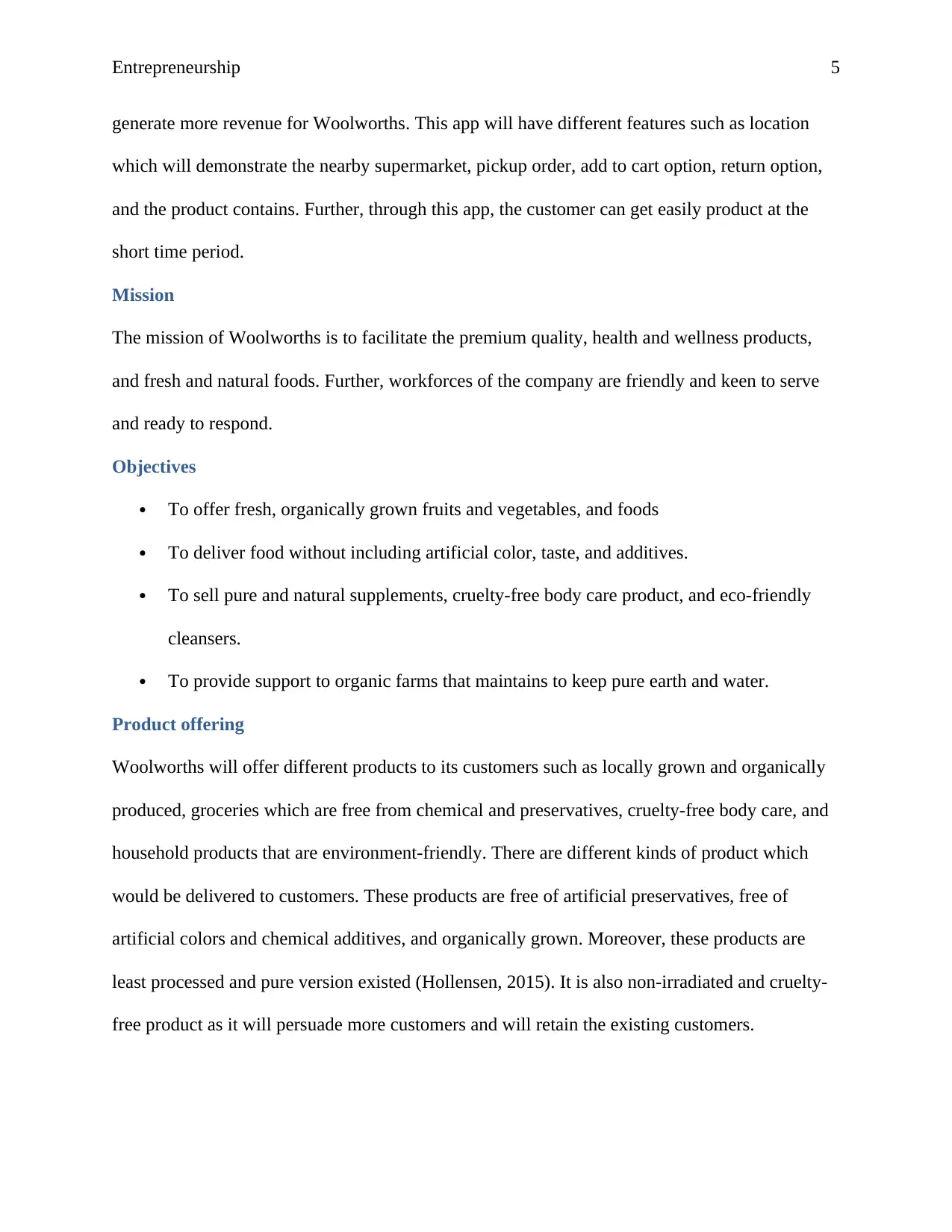
Entrepreneurship 5
generate more revenue for Woolworths. This app will have different features such as location
which will demonstrate the nearby supermarket, pickup order, add to cart option, return option,
and the product contains. Further, through this app, the customer can get easily product at the
short time period.
Mission
The mission of Woolworths is to facilitate the premium quality, health and wellness products,
and fresh and natural foods. Further, workforces of the company are friendly and keen to serve
and ready to respond.
Objectives
To offer fresh, organically grown fruits and vegetables, and foods
To deliver food without including artificial color, taste, and additives.
To sell pure and natural supplements, cruelty-free body care product, and eco-friendly
cleansers.
To provide support to organic farms that maintains to keep pure earth and water.
Product offering
Woolworths will offer different products to its customers such as locally grown and organically
produced, groceries which are free from chemical and preservatives, cruelty-free body care, and
household products that are environment-friendly. There are different kinds of product which
would be delivered to customers. These products are free of artificial preservatives, free of
artificial colors and chemical additives, and organically grown. Moreover, these products are
least processed and pure version existed (Hollensen, 2015). It is also non-irradiated and cruelty-
free product as it will persuade more customers and will retain the existing customers.
generate more revenue for Woolworths. This app will have different features such as location
which will demonstrate the nearby supermarket, pickup order, add to cart option, return option,
and the product contains. Further, through this app, the customer can get easily product at the
short time period.
Mission
The mission of Woolworths is to facilitate the premium quality, health and wellness products,
and fresh and natural foods. Further, workforces of the company are friendly and keen to serve
and ready to respond.
Objectives
To offer fresh, organically grown fruits and vegetables, and foods
To deliver food without including artificial color, taste, and additives.
To sell pure and natural supplements, cruelty-free body care product, and eco-friendly
cleansers.
To provide support to organic farms that maintains to keep pure earth and water.
Product offering
Woolworths will offer different products to its customers such as locally grown and organically
produced, groceries which are free from chemical and preservatives, cruelty-free body care, and
household products that are environment-friendly. There are different kinds of product which
would be delivered to customers. These products are free of artificial preservatives, free of
artificial colors and chemical additives, and organically grown. Moreover, these products are
least processed and pure version existed (Hollensen, 2015). It is also non-irradiated and cruelty-
free product as it will persuade more customers and will retain the existing customers.
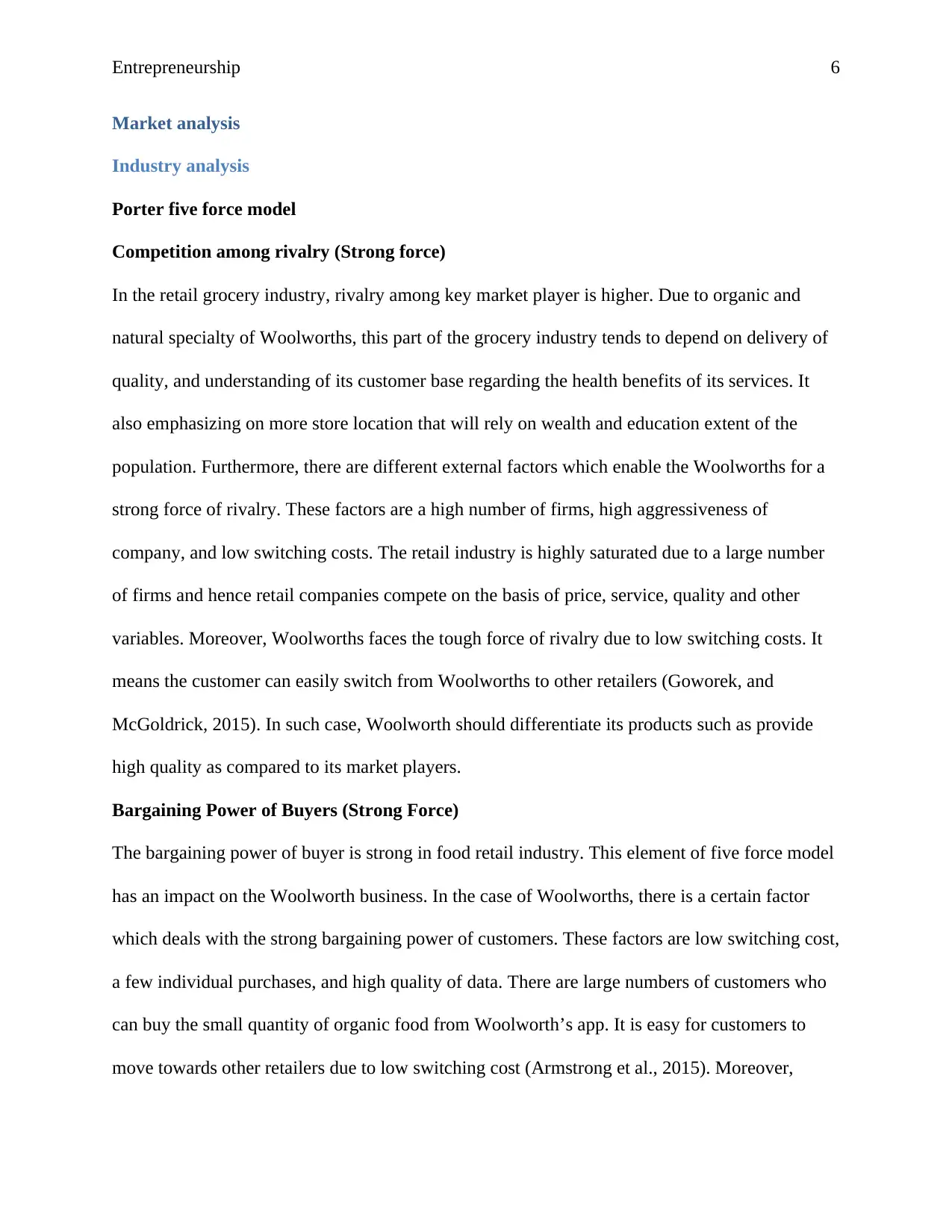
Entrepreneurship 6
Market analysis
Industry analysis
Porter five force model
Competition among rivalry (Strong force)
In the retail grocery industry, rivalry among key market player is higher. Due to organic and
natural specialty of Woolworths, this part of the grocery industry tends to depend on delivery of
quality, and understanding of its customer base regarding the health benefits of its services. It
also emphasizing on more store location that will rely on wealth and education extent of the
population. Furthermore, there are different external factors which enable the Woolworths for a
strong force of rivalry. These factors are a high number of firms, high aggressiveness of
company, and low switching costs. The retail industry is highly saturated due to a large number
of firms and hence retail companies compete on the basis of price, service, quality and other
variables. Moreover, Woolworths faces the tough force of rivalry due to low switching costs. It
means the customer can easily switch from Woolworths to other retailers (Goworek, and
McGoldrick, 2015). In such case, Woolworth should differentiate its products such as provide
high quality as compared to its market players.
Bargaining Power of Buyers (Strong Force)
The bargaining power of buyer is strong in food retail industry. This element of five force model
has an impact on the Woolworth business. In the case of Woolworths, there is a certain factor
which deals with the strong bargaining power of customers. These factors are low switching cost,
a few individual purchases, and high quality of data. There are large numbers of customers who
can buy the small quantity of organic food from Woolworth’s app. It is easy for customers to
move towards other retailers due to low switching cost (Armstrong et al., 2015). Moreover,
Market analysis
Industry analysis
Porter five force model
Competition among rivalry (Strong force)
In the retail grocery industry, rivalry among key market player is higher. Due to organic and
natural specialty of Woolworths, this part of the grocery industry tends to depend on delivery of
quality, and understanding of its customer base regarding the health benefits of its services. It
also emphasizing on more store location that will rely on wealth and education extent of the
population. Furthermore, there are different external factors which enable the Woolworths for a
strong force of rivalry. These factors are a high number of firms, high aggressiveness of
company, and low switching costs. The retail industry is highly saturated due to a large number
of firms and hence retail companies compete on the basis of price, service, quality and other
variables. Moreover, Woolworths faces the tough force of rivalry due to low switching costs. It
means the customer can easily switch from Woolworths to other retailers (Goworek, and
McGoldrick, 2015). In such case, Woolworth should differentiate its products such as provide
high quality as compared to its market players.
Bargaining Power of Buyers (Strong Force)
The bargaining power of buyer is strong in food retail industry. This element of five force model
has an impact on the Woolworth business. In the case of Woolworths, there is a certain factor
which deals with the strong bargaining power of customers. These factors are low switching cost,
a few individual purchases, and high quality of data. There are large numbers of customers who
can buy the small quantity of organic food from Woolworth’s app. It is easy for customers to
move towards other retailers due to low switching cost (Armstrong et al., 2015). Moreover,
⊘ This is a preview!⊘
Do you want full access?
Subscribe today to unlock all pages.

Trusted by 1+ million students worldwide
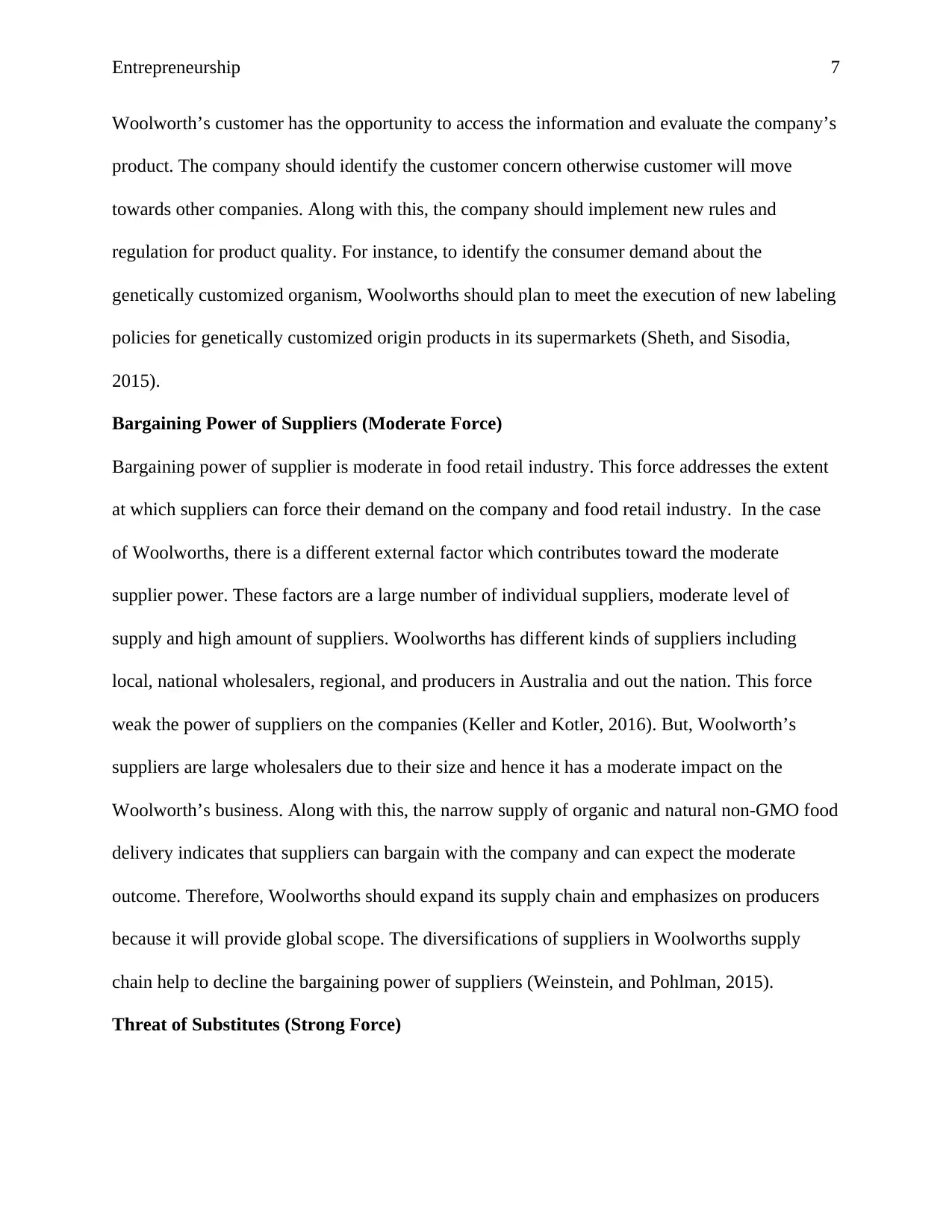
Entrepreneurship 7
Woolworth’s customer has the opportunity to access the information and evaluate the company’s
product. The company should identify the customer concern otherwise customer will move
towards other companies. Along with this, the company should implement new rules and
regulation for product quality. For instance, to identify the consumer demand about the
genetically customized organism, Woolworths should plan to meet the execution of new labeling
policies for genetically customized origin products in its supermarkets (Sheth, and Sisodia,
2015).
Bargaining Power of Suppliers (Moderate Force)
Bargaining power of supplier is moderate in food retail industry. This force addresses the extent
at which suppliers can force their demand on the company and food retail industry. In the case
of Woolworths, there is a different external factor which contributes toward the moderate
supplier power. These factors are a large number of individual suppliers, moderate level of
supply and high amount of suppliers. Woolworths has different kinds of suppliers including
local, national wholesalers, regional, and producers in Australia and out the nation. This force
weak the power of suppliers on the companies (Keller and Kotler, 2016). But, Woolworth’s
suppliers are large wholesalers due to their size and hence it has a moderate impact on the
Woolworth’s business. Along with this, the narrow supply of organic and natural non-GMO food
delivery indicates that suppliers can bargain with the company and can expect the moderate
outcome. Therefore, Woolworths should expand its supply chain and emphasizes on producers
because it will provide global scope. The diversifications of suppliers in Woolworths supply
chain help to decline the bargaining power of suppliers (Weinstein, and Pohlman, 2015).
Threat of Substitutes (Strong Force)
Woolworth’s customer has the opportunity to access the information and evaluate the company’s
product. The company should identify the customer concern otherwise customer will move
towards other companies. Along with this, the company should implement new rules and
regulation for product quality. For instance, to identify the consumer demand about the
genetically customized organism, Woolworths should plan to meet the execution of new labeling
policies for genetically customized origin products in its supermarkets (Sheth, and Sisodia,
2015).
Bargaining Power of Suppliers (Moderate Force)
Bargaining power of supplier is moderate in food retail industry. This force addresses the extent
at which suppliers can force their demand on the company and food retail industry. In the case
of Woolworths, there is a different external factor which contributes toward the moderate
supplier power. These factors are a large number of individual suppliers, moderate level of
supply and high amount of suppliers. Woolworths has different kinds of suppliers including
local, national wholesalers, regional, and producers in Australia and out the nation. This force
weak the power of suppliers on the companies (Keller and Kotler, 2016). But, Woolworth’s
suppliers are large wholesalers due to their size and hence it has a moderate impact on the
Woolworth’s business. Along with this, the narrow supply of organic and natural non-GMO food
delivery indicates that suppliers can bargain with the company and can expect the moderate
outcome. Therefore, Woolworths should expand its supply chain and emphasizes on producers
because it will provide global scope. The diversifications of suppliers in Woolworths supply
chain help to decline the bargaining power of suppliers (Weinstein, and Pohlman, 2015).
Threat of Substitutes (Strong Force)
Paraphrase This Document
Need a fresh take? Get an instant paraphrase of this document with our AI Paraphraser
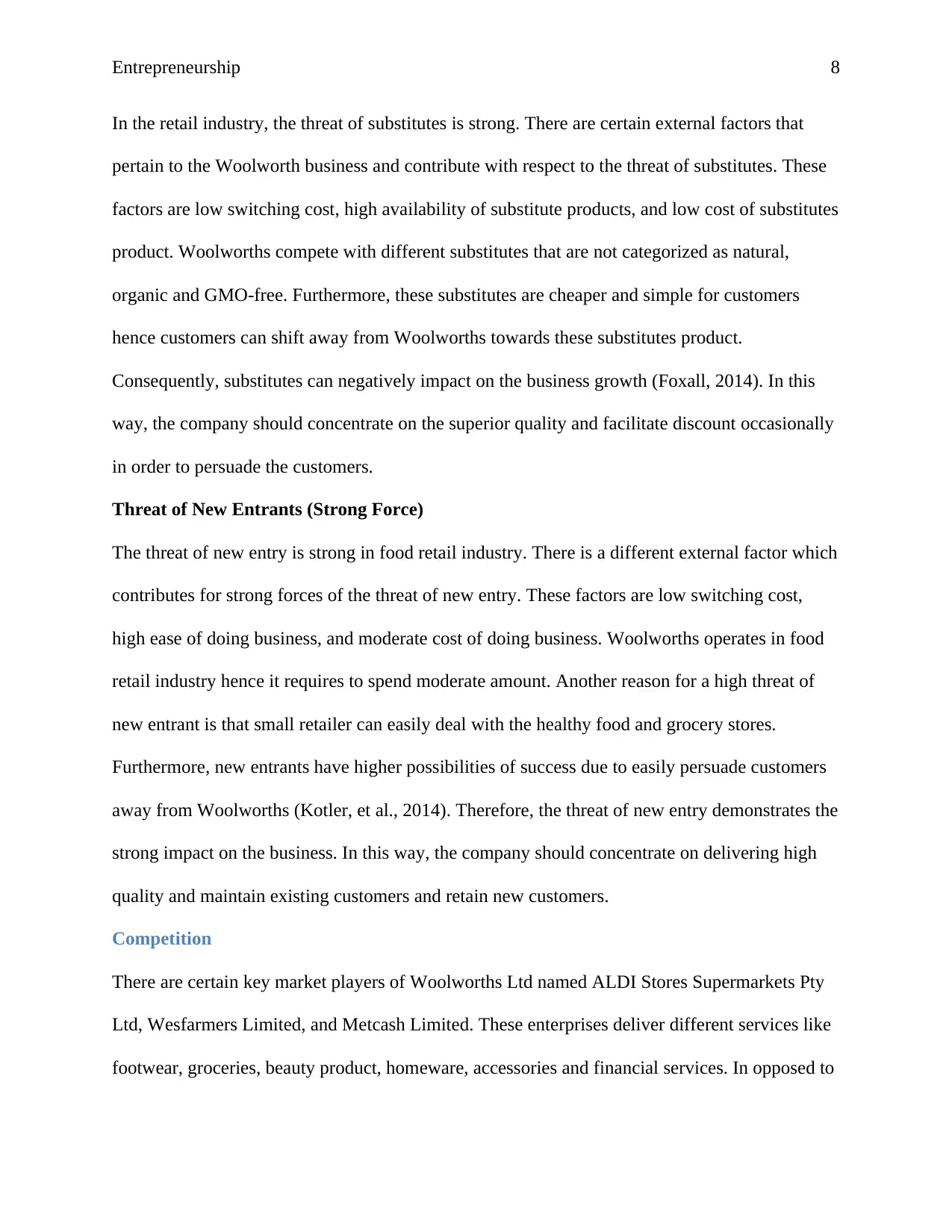
Entrepreneurship 8
In the retail industry, the threat of substitutes is strong. There are certain external factors that
pertain to the Woolworth business and contribute with respect to the threat of substitutes. These
factors are low switching cost, high availability of substitute products, and low cost of substitutes
product. Woolworths compete with different substitutes that are not categorized as natural,
organic and GMO-free. Furthermore, these substitutes are cheaper and simple for customers
hence customers can shift away from Woolworths towards these substitutes product.
Consequently, substitutes can negatively impact on the business growth (Foxall, 2014). In this
way, the company should concentrate on the superior quality and facilitate discount occasionally
in order to persuade the customers.
Threat of New Entrants (Strong Force)
The threat of new entry is strong in food retail industry. There is a different external factor which
contributes for strong forces of the threat of new entry. These factors are low switching cost,
high ease of doing business, and moderate cost of doing business. Woolworths operates in food
retail industry hence it requires to spend moderate amount. Another reason for a high threat of
new entrant is that small retailer can easily deal with the healthy food and grocery stores.
Furthermore, new entrants have higher possibilities of success due to easily persuade customers
away from Woolworths (Kotler, et al., 2014). Therefore, the threat of new entry demonstrates the
strong impact on the business. In this way, the company should concentrate on delivering high
quality and maintain existing customers and retain new customers.
Competition
There are certain key market players of Woolworths Ltd named ALDI Stores Supermarkets Pty
Ltd, Wesfarmers Limited, and Metcash Limited. These enterprises deliver different services like
footwear, groceries, beauty product, homeware, accessories and financial services. In opposed to
In the retail industry, the threat of substitutes is strong. There are certain external factors that
pertain to the Woolworth business and contribute with respect to the threat of substitutes. These
factors are low switching cost, high availability of substitute products, and low cost of substitutes
product. Woolworths compete with different substitutes that are not categorized as natural,
organic and GMO-free. Furthermore, these substitutes are cheaper and simple for customers
hence customers can shift away from Woolworths towards these substitutes product.
Consequently, substitutes can negatively impact on the business growth (Foxall, 2014). In this
way, the company should concentrate on the superior quality and facilitate discount occasionally
in order to persuade the customers.
Threat of New Entrants (Strong Force)
The threat of new entry is strong in food retail industry. There is a different external factor which
contributes for strong forces of the threat of new entry. These factors are low switching cost,
high ease of doing business, and moderate cost of doing business. Woolworths operates in food
retail industry hence it requires to spend moderate amount. Another reason for a high threat of
new entrant is that small retailer can easily deal with the healthy food and grocery stores.
Furthermore, new entrants have higher possibilities of success due to easily persuade customers
away from Woolworths (Kotler, et al., 2014). Therefore, the threat of new entry demonstrates the
strong impact on the business. In this way, the company should concentrate on delivering high
quality and maintain existing customers and retain new customers.
Competition
There are certain key market players of Woolworths Ltd named ALDI Stores Supermarkets Pty
Ltd, Wesfarmers Limited, and Metcash Limited. These enterprises deliver different services like
footwear, groceries, beauty product, homeware, accessories and financial services. In opposed to
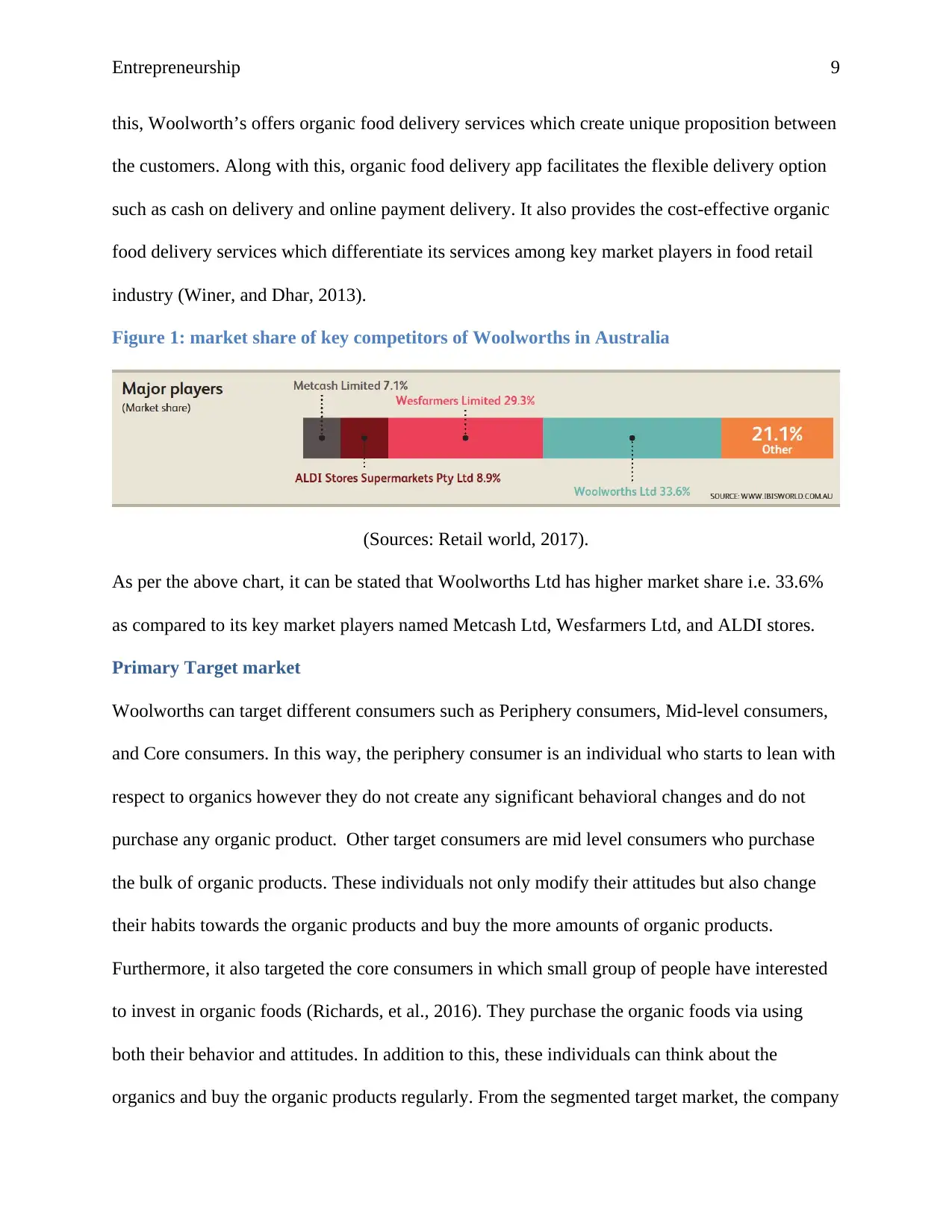
Entrepreneurship 9
this, Woolworth’s offers organic food delivery services which create unique proposition between
the customers. Along with this, organic food delivery app facilitates the flexible delivery option
such as cash on delivery and online payment delivery. It also provides the cost-effective organic
food delivery services which differentiate its services among key market players in food retail
industry (Winer, and Dhar, 2013).
Figure 1: market share of key competitors of Woolworths in Australia
(Sources: Retail world, 2017).
As per the above chart, it can be stated that Woolworths Ltd has higher market share i.e. 33.6%
as compared to its key market players named Metcash Ltd, Wesfarmers Ltd, and ALDI stores.
Primary Target market
Woolworths can target different consumers such as Periphery consumers, Mid-level consumers,
and Core consumers. In this way, the periphery consumer is an individual who starts to lean with
respect to organics however they do not create any significant behavioral changes and do not
purchase any organic product. Other target consumers are mid level consumers who purchase
the bulk of organic products. These individuals not only modify their attitudes but also change
their habits towards the organic products and buy the more amounts of organic products.
Furthermore, it also targeted the core consumers in which small group of people have interested
to invest in organic foods (Richards, et al., 2016). They purchase the organic foods via using
both their behavior and attitudes. In addition to this, these individuals can think about the
organics and buy the organic products regularly. From the segmented target market, the company
this, Woolworth’s offers organic food delivery services which create unique proposition between
the customers. Along with this, organic food delivery app facilitates the flexible delivery option
such as cash on delivery and online payment delivery. It also provides the cost-effective organic
food delivery services which differentiate its services among key market players in food retail
industry (Winer, and Dhar, 2013).
Figure 1: market share of key competitors of Woolworths in Australia
(Sources: Retail world, 2017).
As per the above chart, it can be stated that Woolworths Ltd has higher market share i.e. 33.6%
as compared to its key market players named Metcash Ltd, Wesfarmers Ltd, and ALDI stores.
Primary Target market
Woolworths can target different consumers such as Periphery consumers, Mid-level consumers,
and Core consumers. In this way, the periphery consumer is an individual who starts to lean with
respect to organics however they do not create any significant behavioral changes and do not
purchase any organic product. Other target consumers are mid level consumers who purchase
the bulk of organic products. These individuals not only modify their attitudes but also change
their habits towards the organic products and buy the more amounts of organic products.
Furthermore, it also targeted the core consumers in which small group of people have interested
to invest in organic foods (Richards, et al., 2016). They purchase the organic foods via using
both their behavior and attitudes. In addition to this, these individuals can think about the
organics and buy the organic products regularly. From the segmented target market, the company
⊘ This is a preview!⊘
Do you want full access?
Subscribe today to unlock all pages.

Trusted by 1+ million students worldwide
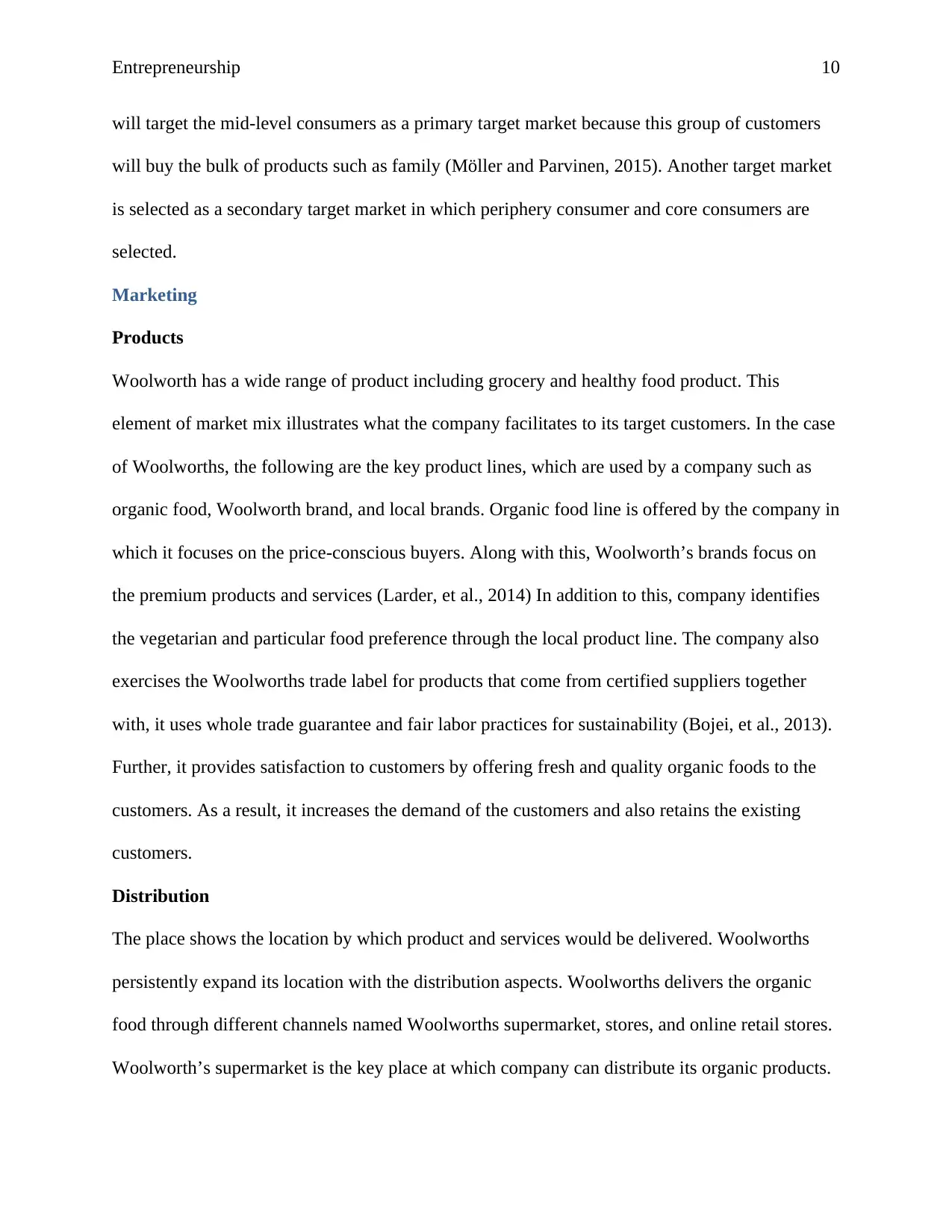
Entrepreneurship 10
will target the mid-level consumers as a primary target market because this group of customers
will buy the bulk of products such as family (Möller and Parvinen, 2015). Another target market
is selected as a secondary target market in which periphery consumer and core consumers are
selected.
Marketing
Products
Woolworth has a wide range of product including grocery and healthy food product. This
element of market mix illustrates what the company facilitates to its target customers. In the case
of Woolworths, the following are the key product lines, which are used by a company such as
organic food, Woolworth brand, and local brands. Organic food line is offered by the company in
which it focuses on the price-conscious buyers. Along with this, Woolworth’s brands focus on
the premium products and services (Larder, et al., 2014) In addition to this, company identifies
the vegetarian and particular food preference through the local product line. The company also
exercises the Woolworths trade label for products that come from certified suppliers together
with, it uses whole trade guarantee and fair labor practices for sustainability (Bojei, et al., 2013).
Further, it provides satisfaction to customers by offering fresh and quality organic foods to the
customers. As a result, it increases the demand of the customers and also retains the existing
customers.
Distribution
The place shows the location by which product and services would be delivered. Woolworths
persistently expand its location with the distribution aspects. Woolworths delivers the organic
food through different channels named Woolworths supermarket, stores, and online retail stores.
Woolworth’s supermarket is the key place at which company can distribute its organic products.
will target the mid-level consumers as a primary target market because this group of customers
will buy the bulk of products such as family (Möller and Parvinen, 2015). Another target market
is selected as a secondary target market in which periphery consumer and core consumers are
selected.
Marketing
Products
Woolworth has a wide range of product including grocery and healthy food product. This
element of market mix illustrates what the company facilitates to its target customers. In the case
of Woolworths, the following are the key product lines, which are used by a company such as
organic food, Woolworth brand, and local brands. Organic food line is offered by the company in
which it focuses on the price-conscious buyers. Along with this, Woolworth’s brands focus on
the premium products and services (Larder, et al., 2014) In addition to this, company identifies
the vegetarian and particular food preference through the local product line. The company also
exercises the Woolworths trade label for products that come from certified suppliers together
with, it uses whole trade guarantee and fair labor practices for sustainability (Bojei, et al., 2013).
Further, it provides satisfaction to customers by offering fresh and quality organic foods to the
customers. As a result, it increases the demand of the customers and also retains the existing
customers.
Distribution
The place shows the location by which product and services would be delivered. Woolworths
persistently expand its location with the distribution aspects. Woolworths delivers the organic
food through different channels named Woolworths supermarket, stores, and online retail stores.
Woolworth’s supermarket is the key place at which company can distribute its organic products.
Paraphrase This Document
Need a fresh take? Get an instant paraphrase of this document with our AI Paraphraser
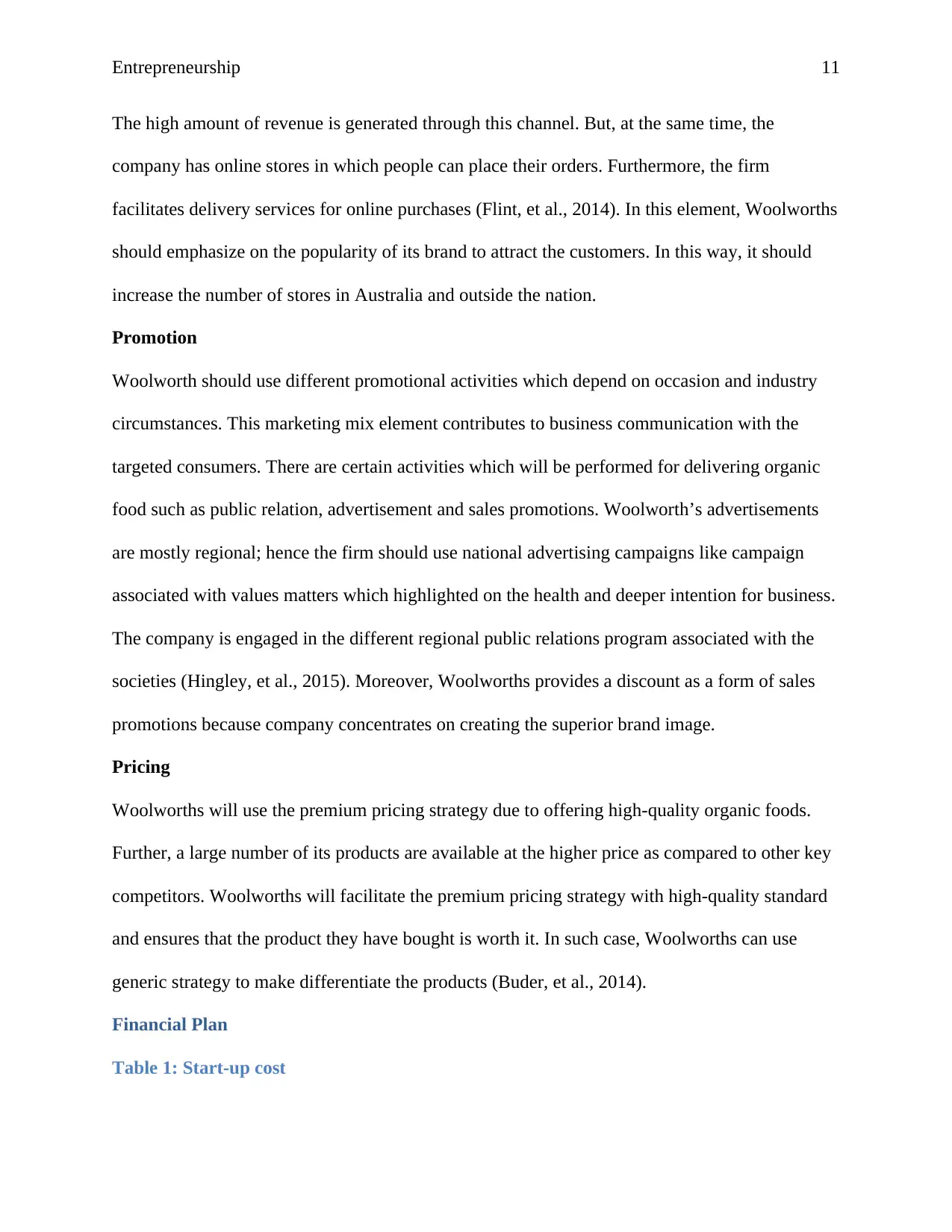
Entrepreneurship 11
The high amount of revenue is generated through this channel. But, at the same time, the
company has online stores in which people can place their orders. Furthermore, the firm
facilitates delivery services for online purchases (Flint, et al., 2014). In this element, Woolworths
should emphasize on the popularity of its brand to attract the customers. In this way, it should
increase the number of stores in Australia and outside the nation.
Promotion
Woolworth should use different promotional activities which depend on occasion and industry
circumstances. This marketing mix element contributes to business communication with the
targeted consumers. There are certain activities which will be performed for delivering organic
food such as public relation, advertisement and sales promotions. Woolworth’s advertisements
are mostly regional; hence the firm should use national advertising campaigns like campaign
associated with values matters which highlighted on the health and deeper intention for business.
The company is engaged in the different regional public relations program associated with the
societies (Hingley, et al., 2015). Moreover, Woolworths provides a discount as a form of sales
promotions because company concentrates on creating the superior brand image.
Pricing
Woolworths will use the premium pricing strategy due to offering high-quality organic foods.
Further, a large number of its products are available at the higher price as compared to other key
competitors. Woolworths will facilitate the premium pricing strategy with high-quality standard
and ensures that the product they have bought is worth it. In such case, Woolworths can use
generic strategy to make differentiate the products (Buder, et al., 2014).
Financial Plan
Table 1: Start-up cost
The high amount of revenue is generated through this channel. But, at the same time, the
company has online stores in which people can place their orders. Furthermore, the firm
facilitates delivery services for online purchases (Flint, et al., 2014). In this element, Woolworths
should emphasize on the popularity of its brand to attract the customers. In this way, it should
increase the number of stores in Australia and outside the nation.
Promotion
Woolworth should use different promotional activities which depend on occasion and industry
circumstances. This marketing mix element contributes to business communication with the
targeted consumers. There are certain activities which will be performed for delivering organic
food such as public relation, advertisement and sales promotions. Woolworth’s advertisements
are mostly regional; hence the firm should use national advertising campaigns like campaign
associated with values matters which highlighted on the health and deeper intention for business.
The company is engaged in the different regional public relations program associated with the
societies (Hingley, et al., 2015). Moreover, Woolworths provides a discount as a form of sales
promotions because company concentrates on creating the superior brand image.
Pricing
Woolworths will use the premium pricing strategy due to offering high-quality organic foods.
Further, a large number of its products are available at the higher price as compared to other key
competitors. Woolworths will facilitate the premium pricing strategy with high-quality standard
and ensures that the product they have bought is worth it. In such case, Woolworths can use
generic strategy to make differentiate the products (Buder, et al., 2014).
Financial Plan
Table 1: Start-up cost
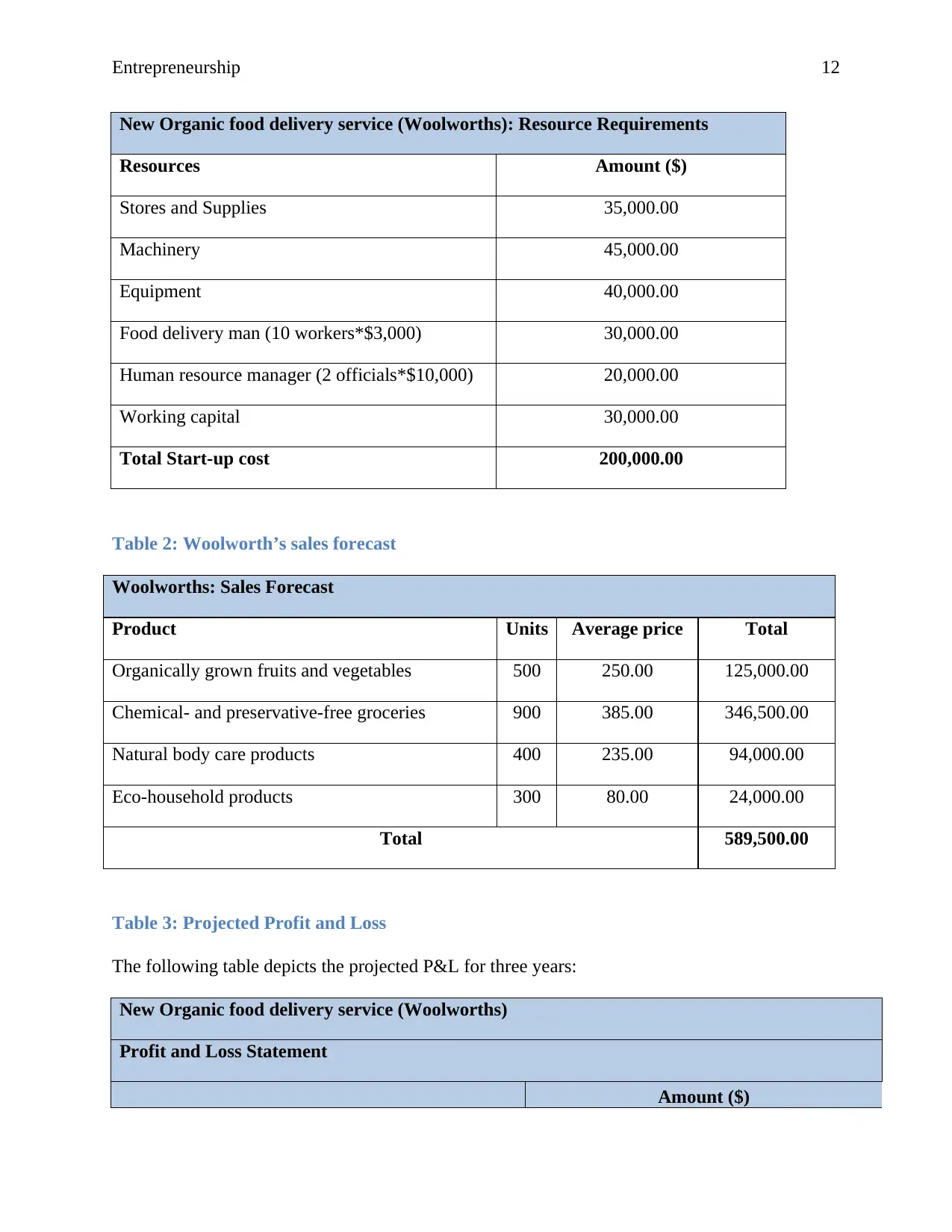
Entrepreneurship 12
New Organic food delivery service (Woolworths): Resource Requirements
Resources Amount ($)
Stores and Supplies 35,000.00
Machinery 45,000.00
Equipment 40,000.00
Food delivery man (10 workers*$3,000) 30,000.00
Human resource manager (2 officials*$10,000) 20,000.00
Working capital 30,000.00
Total Start-up cost 200,000.00
Table 2: Woolworth’s sales forecast
Woolworths: Sales Forecast
Product Units Average price Total
Organically grown fruits and vegetables 500 250.00 125,000.00
Chemical- and preservative-free groceries 900 385.00 346,500.00
Natural body care products 400 235.00 94,000.00
Eco-household products 300 80.00 24,000.00
Total 589,500.00
Table 3: Projected Profit and Loss
The following table depicts the projected P&L for three years:
New Organic food delivery service (Woolworths)
Profit and Loss Statement
Amount ($)
New Organic food delivery service (Woolworths): Resource Requirements
Resources Amount ($)
Stores and Supplies 35,000.00
Machinery 45,000.00
Equipment 40,000.00
Food delivery man (10 workers*$3,000) 30,000.00
Human resource manager (2 officials*$10,000) 20,000.00
Working capital 30,000.00
Total Start-up cost 200,000.00
Table 2: Woolworth’s sales forecast
Woolworths: Sales Forecast
Product Units Average price Total
Organically grown fruits and vegetables 500 250.00 125,000.00
Chemical- and preservative-free groceries 900 385.00 346,500.00
Natural body care products 400 235.00 94,000.00
Eco-household products 300 80.00 24,000.00
Total 589,500.00
Table 3: Projected Profit and Loss
The following table depicts the projected P&L for three years:
New Organic food delivery service (Woolworths)
Profit and Loss Statement
Amount ($)
⊘ This is a preview!⊘
Do you want full access?
Subscribe today to unlock all pages.

Trusted by 1+ million students worldwide
1 out of 19
Related Documents
Your All-in-One AI-Powered Toolkit for Academic Success.
+13062052269
info@desklib.com
Available 24*7 on WhatsApp / Email
![[object Object]](/_next/static/media/star-bottom.7253800d.svg)
Unlock your academic potential
Copyright © 2020–2025 A2Z Services. All Rights Reserved. Developed and managed by ZUCOL.




